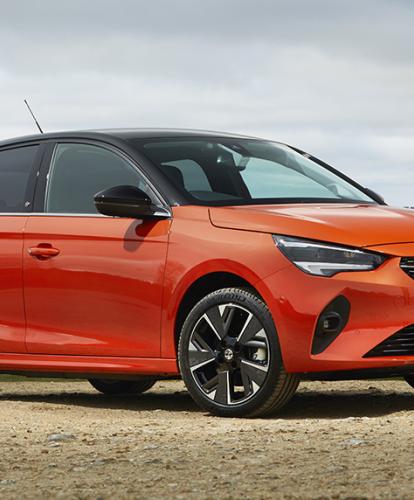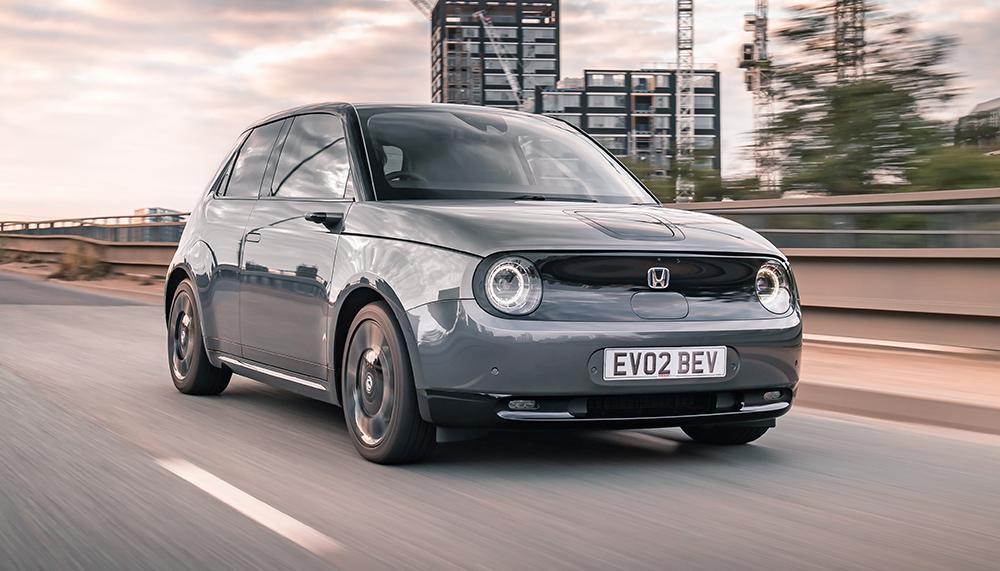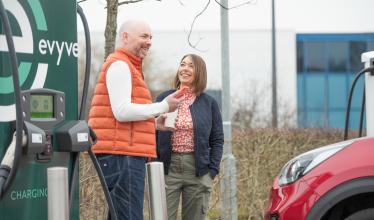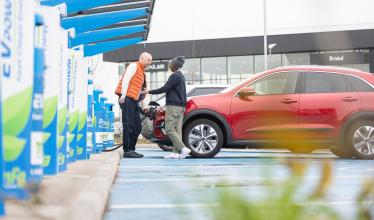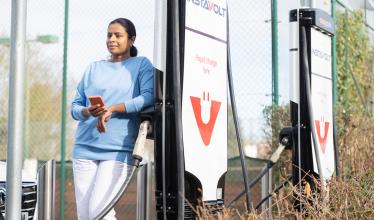Zap-Map verdict: “Excellent value and comfortable to drive, the Vauxhall Corsa-e blends a good range with short recharging times.”

- ● OTR: £26,640
- ● Category: Supermini
- ● Tax: £0 VED – 0% BIK
- ● Cost to charge: £8.00
- ● Emissions: 0 g/km CO2
- ● Cost per mile of range: £127
Range & charging

Vauxhall’s Corsa-e looks to offer buyers a simple choice. You could pick a ‘normal’ petrol or diesel Vauxhall Corsa or, lined up alongside these models, you could pick an electric Corsa instead. Offering a good range, ultra-rapid charging speeds, and the sensible supermini package drivers will expect from a Corsa, Vauxhall is making the most of its parent group’s investment in EVs.
There is one configuration available:
-
- ● Vauxhall Corsa-e – 100 kW – 50 kWh – 209 miles
On test is the Vauxhall Corsa-e, in top-of-the-range Elite Nav Premium trim, fitted with the 11 kW AC on-board charger. This sees drivers access a supermini with an official range of just over 200 miles on a charge – more than enough for most situations. Unlike most of its rival supermini offerings however – apart from those sharing a platform and powertrain.- the Corsa-e is able to be charged as fast as anything else in its sector. The 100 kW DC ultra-rapid charging capabilities mean that even when driving more than 200 miles in one go, the ability to top-up quickly can see a charge to 80% in as little as half an hour.
It’s not just DC charging that’s quick however, as the Corsa-e comes with a 7.4 kW on-board charger as standard, but is also available with an 11 kW on-board charger across the range. This can see a full recharge in around three and a half hours. Compared to the likes of the Mini Electric, Honda e, BMW i3, and Renault Zoe, the Corsa-e is streaks ahead in terms of charging speeds.
In real-world driving, I struggled to achieve both the official range (entirely normal) and the expected driving range. Based on experience, I tend to find EVs reach around 85-90% of their official range without much effort. This would put the Corsa-e’s predicted real range at around 180 miles. In fact, I was getting about 160 miles of range per charge, but have to say that the chilly January weather would have played a part in this. I’d expect this to be boosted to 170+ miles on a charge in better weather but, like the DS 3 Crossback E-Tense – which uses the same components but in a crossover body – the real-world range looks to be at the bottom end of what I’d want to see based not he official figures.
On the road

To drive, the Vauxhall can’t compete with the Mini, Honda, and BMW mentioned above, which all focus on offering an engaging driving experience, and succeed. Instead, the Corsa-e is very ‘Corsa-ish’ – it’s a good all-rounder, with no particular focus on comfort or dynamics, but a car that will deal with everything normally thrown at a supermini simply and with ease.
It’s best suited to town driving (in electric supermini shocker), but copes well with twister country roads and motorways too. Thanks in part to the electric powertrain, it’s refined on faster roads, and the suspension set-up offers a more supple ride than that found in the Peugeot e-208 sister-car. I prefer the Peugeot’s better dynamism, but understand that many won’t agree, and would prefer the softer springs found on the Vauxhall.
In terms of performance, the Corsa-e again can’t challenge many of its rivals for outright pace, but the 100 kW motor makes light work of all the usual driving routes. It doesn’t struggle at motorway pace, has the quick response you need in town, and comfortably has enough about it to pull the Corsa-e along. I’d recommend leaving the Vauxhall in Sport mode for improved performance, otherwise the Normal – and in particular Eco – left me feeling underwhelmed by the performance. Sport gives you that instant shove we’ve come to expect from just about all EVs, but that’s not really present in other settings.
Comfort & Practicality

The Vauxhall Corsa-e won’t disappoint anyone in the market for a supermini when looking at practicality and the interior. It’s a compact car, but sizeable enough to be able to seat four adults comfortably, and deal with a bit of luggage. The boot isn’t the largest in its class, but it’s not tiny either. If you’re prioritising outright load area, particularly with a large pushchair or similar, look elsewhere, but the Corsa-e will deal with a supermarket shop etc with ease. The battery is placed in the floor as with most EVs, so interior space is essentially uncompromised compared to the standard Corsa.
The rest of the cabin is reasonably well appointed. Materials used are good rather than excellent, and the design is a bit plain and dark for a supermini, where splashes of colour and bolder designs are more acceptable than in larger cars. It’s likely just the trim on the test vehicle, but the Corsa-e felt a bit too grown-up compared to some of the excellent interiors of other superminis. The switchgear, screens, and other systems are shared with much of the compact PSA Group fleet, but work well, are nicely designed, and fall easily to hand. Like much of the rest of the Corsa-e, its a good Jack-of-all-trades rather than a master of anything.
Tech & Specifications

Equipment levels are good throughout the Corsa-e range, with three trims to pick from. All include touchscreen navigation, Apple CarPlay/Android Auto connectivity, 16-inch alloy wheels, 7-inch digital instrument cluster, keyless start, rear parking sensors, climate control, and automatic lights and wipers. Higher trims upgrade the alloys to 17-inch wheels, add sensors front and rear for parking and include a reversing camera, as well as a larger 10-inch touchscreen infotainment system. There’s also the important choice between 7.4 kW and 11 kW on-board chargers. I’d always opt for the higher power option if funds allow, to future-proof the car and allow for faster charging at public points.
In fact, charging is a big factor in considering the Vauxhall Corsa-e, particularly when comparing the Vauxhall with the Zoe for example. The Renault is the only one of those listed above to have a longer range than the Vauxhall – it has a range of up to 245 miles from a similarly sized battery – but 50 kW DC rapid charging is an option rather than standard, and only allows CCS charging at half the speed those that drive a Corsa-e can. Buyers will need to weigh whether a longer outright range or faster charging speeds are better suited to their needs in this regard. In fact, the Corsa-e’s biggest rivals come effectively from in-house. The Peugeot e-208 is an identical car under the skin, but drives better in my opinion, and looks more distinctive inside and out. I’d personally pick the Peugeot over the Vauxhall, but the Corsa-e is a good little EV, and definitely a decent pick for anyone in the market for a supermini – electric or otherwise.
